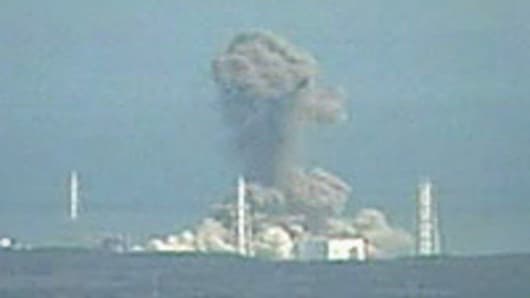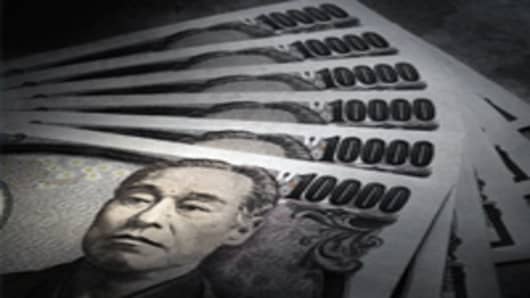The complexity and uncertainty surrounding Japan's nuclear crisis has created a great divide between investors who are now running from risk and those who think they can ride it out.
The tragic 9.0 earthquake that hit Japan last Friday, sending a giant tsunami across miles of coastal land, would surely impact the Japanese economy. But investors are worried that the lingering uncertainty around the damaged Fukushima Daiichi reactors adds much more risk and could potentially create more economic chaos if their worst fears about leaking radiation are realized.
From currencies to bonds to commodities markets, traders have been studying up on nuclear power. The conventional thinking mirrors what officials have said: It's worse than Three Mile Island, but better than Chernobyl. The operator of the crippled nuclear plant said late Wednesday it was close to completing a new power line to restore electricity to the complex, which would presumably allow workers to once more attempt to cool the nuclear cores of several reactors.
Markets should see the same dynamic Thursday, as investors watch every development and comment on the nuclear crisis. There is also important data - weekly jobless claims and the Consumer Price Index inflation data. Both are released at 8:30 a.m. Industrial production is reported at 9:15 a.m., and leading indicators and the Philadelphia Fed survey are reported at 10 a.m.
The Yen will also be in focus Thursday, after a big swing to a new record high against the dollar in late afternoon trading Wednesday.
"The market is trading on egg shells right now," said Brian Edmonds, who heads Treasury trading at Cantor Fitzgerald. Edmonds said the bond market is sensitive to every headline concerning the Japanese nuclear problem. For instance, markets even reacted sharply Wednesday to a vague headline from a European official, who said a nuclear catastrophe was just hours away. It was later clarified that the official had no special knowledge of the situation.
"You clearly have a flight-to-quality trade that is forcing people back into Treasurys," Edmonds said. The 10-year yield slipped below 3.2 percent, and was at 3.18 percent Wednesday evening. "We're looking at yield levels where nobody wants to buy."
Stocks have sold off now more than many analysts had expected to see in a short-term correction. The S&P 500 was down nearly 2 percent Wednesday at 1256, and is now down about 6 percent since the Feb. 18 multi-year high. The Dow Wednesday fell 2 percent to 11,613, and the Nasdaq was off 1.9 percent to 2616.
"It's factored in a meltdown. It's not pricing in anything beyond that," said Carter Worth, chief market technician at Oppenheimer Asset Management. Worth said a major reference point for the S&P 500 would be 1220. "The 150-day moving average is right there...My guess is we're going to squeak through" and stay above it, he said.
Worth said the sell off is healthy after the market's strong advance. "I would say it would be a little bit healthier would have been sideways, more of a resting rather than a giveback. Until the last day or two it was sideways. The (possible) nuclear meltdown has taken it more to a tipping point," he said.
Ed Keon, portfolio manager at Quantitative Management Associates, said he is assessing the situation constantly and still favors stocks though he expects some earnings impact. "It's impossible to to say how much this will affect the U.S. economy and what lasting damage it will do to the U.S. stock market and the U.S. recovery until we have a better handle on what the outcome is going to be. We were optimistic a few days ago before this whole thing, and I like to think the fundamentals of the U.S. still look pretty good. But we can't rule out the worse case scenarios we are envisioning," he said.
"There's a long history of cases where you get a couple days of sharp sell offs and then you get a quick rebound. If your goal is not just to make money today but over the course of the year and multiple years, usually selling at the first sign of trouble could end up whipsawing you," Keon said.
Perhaps the most extraordinary move Wednesday was in the late trading of dollar yen. After the yen broke above its all time high, it sent the dollar skidding. Dollar yen hit a low around 77 but later rose back above 78. Traders immediately speculated the Bank of Japan would have to intervene to stop the yen's run, and reports of a Thursday G-7 meeting added to speculation that the intervention would be coordinated by major central banks.
Yen has been on an upswing since the earthquake, amid anticipation of repatriation flows to cover the cost of rebuilding. Japanese Finance Minister Yoshihiko Noda said early Thursday in Japan that he was watching the currency market, and that it was nervous moves in thin markets. He also declined comment on intervention.
"I'm perplexed. You saw Japanese officials saying there hasn't been that many repatriation flows. It's been people front running it," said Brown Brothers Harriman senior currency strategist Win Thin, in an interview before Noda's latest comment.
The rising yen is particularly painful to Japan's exporters, which have already been hurt by manufacturing shutdowns, and supply chain and shipping disruptions.
What Else to Watch
Aside from Japan, traders continue to keep an eye on Bahrain and Libya. Oil gained Wednesday, rising $0.78 to $97.96 per barrel, but it was slightly lower in Asian trading.
Weekly jobless claims are also important. Claims increased more than expected last week to 397,000. "The claims numbers have been very volatile on a week to week basis. Last week was up a lot. If it's flat or down a lot, I don't think people will care. If it's up, I think people are positioned to find reasons to believe things are softening up," said Pierpont Securities chief economist Stephen Stanley.
Stanley expects CPI of 0.5 percent and core CPI, excluding food and energy, of 0.1 percent. Producer prices Wednesday rose at their fastest pace in 18 months, boosted by higher food and energy costs. PPI rose 1.6 percent. The number was well above the 0.7 percent rise expected by economists and comes the day after the Federal Reserve noted it was now watching inflation though still sees it as transitory.
Questions? Comments? Email us at marketinsider@cnbc.com





